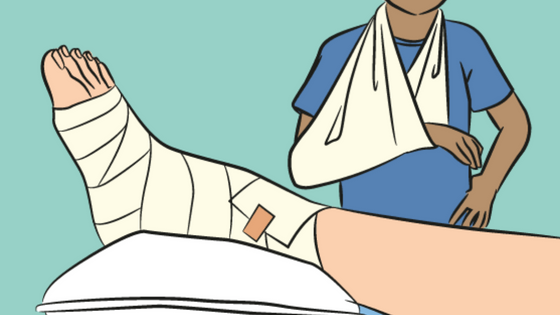You’ve injured yourself but not had any investigation or treatment for it? Struggling to get better? Wondering if you should get it checked out? Here are some signs you need help with your injury.
The First Step
After injuring yourself the first steps of rehabilitation are to apply the R.I.C.E.R. principles. These stand for;
Rest
Rest means, no use of the joint or muscle that has been injured. If you’re not in a position to rest, even for short while, apply the next principles, until you can rest the injury. Rest should take place for at least 72 hours after the injury, or until swelling and inflammation has eased.
Ice
Applying ice to the injury will help reduce the inflammation and help control swelling. There are some alternative schools of thought around this but applying ice is still the main injury first aid.
Compression
Wrap a compression bandage around the injured area. This will help reduce the swelling to the area. Be sure not to wrap it too tight, or you will lose blood and nerve supply to the area, resulting in numbness, tingling and a change in colour to the skin.
Elevation
Elevating the injured area above the height of the heart will also help the reduce swelling.
So, for example, if you’ve sprained an ankle stop doing the activity that caused the injury, apply ice to the ankle for at least 10 to 20 minutes to the ankle. Then wrap the ankle in a compression bandage, lie down and rest the ankle on a couple of pillows . keep applying ice for 10 to 20 minutes each hour for the first 24 hours and then at least every 3 to 4 hours for the next two days.
If you don’t have any ice available, apply the other principles. If you cant immediately rest, apply ice and compression until you can rest – preferably within 24 hours .
The last principle – R is for Refer
This means, refer to a health professional who can make an assessment, investigation and any treatment that may be required.
Failing to do so may prolong your healing, leave you with scar tissue or undiscovered injuries such as sprains, strains, or fractures.
After about 72 hours, your injury may have settled and you probably feel like getting back into your normal activities. However, you might still be getting symptoms from your injury that will be the tell-tale signs that you need to have it treated.
You have referred pain
If you’re getting pain in an area adjacent to the injury you may have referral pain. This can indicate muscular trigger point or neural pain may be present. Referred pain is pain perceived at a location other than the site of the painful origin.
You keep re-injuring the same area
Recurring injury can be an indicator of inefficient movement patterns, restricted mobility, or underlying musculoskeletal issues. Your myotherapist will be able to help correct any imbalances and provide strengthening and mobilising exercises. To help these injuries occur far less frequently!
You have restricted range of movement
Every joint has a range of movement in which it can move. Tension in muscles can restrict the range. If you’re finding you cant move the joint through it’s normal range it may be a sign you need help with your injury. You can probably benefit from some myotherapy, self myofascial release and stretching.
Weakness or tension
Finding that you can do the normal activities you used to before the injury because the joint feels weak or tight. For example, you cant grip as tight as before, or lift as heavy as before. Weakness can present as tension, and both can be treated with massage but also with strengthening.
Who should I see?
If you are feeling any of these symptoms, it’s advisable to see a physiotherapist or a myotherapist. If you think you have done some more serious damage and cant put weight on or move the limb, or are experiencing numbness in the area it’s best to consult your GP.
A myotherapist will take you through a range of tests including range of motion, special tests and palpation of the area to determine what might be the cause of your pain. They will then use a range of modalities such as deep tissue massage, dry needling, TENS, and exercise prescription to help ease the pain, and restore range of motion and get you back to your normal activities.
So if you’re feeling like you just cant shake that injury, book online and have a myotherapist assess it today.





